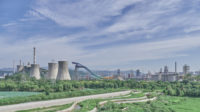Other Olympic Venues
There are more to these Games than just two iconic buildings.
Beijing, China
Various architects
In July 2001, Beijing won the right to host the 2008 Olympics, and it started gearing up immediately. Soon, its Olympic organizing committee chose Sasaki Associates, based in Boston and San Francisco, from 94 entries to design the Olympic Green, the main site for the games, five miles north of the Forbidden City. Sasaki saw its job as creating a framework not only for the Olympics but for integrating the 2,800-acre site with the city as a whole. The firm envisioned private, mixed-use developments lining the green on the east and west and establishing a strong relationship between the public and private realms. It also extended the city’s existing street grid onto the Olympic site, weaving together old and new. Sasaki’s design comprises three key elements: a Forest Park on the north; a diagonal Olympic Axis connecting existing sports facilities from the 1985 Asian Games to the new venues for the Olympics; and a Cultural Axis extending the ancient imperial route that runs north from Tiananmen Square through the Forbidden City. The Olympic Green encompasses about half of the 31 sporting venues to be used during the Games, but none sits directly on the Cultural Axis. As Dennis Pieprz, the president of Sasaki, explains: “We decided to put people at the center of the green, so we reserved the main axis for them and used the major iconic buildings to frame that public space.” Sasaki’s scheme places the Games’ two iconic buildings—the National Stadium and the National Swimming Center—on either side of the axis. A new subway line opens this summer with several stations along the Olympic Green. Although Sasaki wasn’t involved in the landscape architecture, a canal and a tree-lined esplanade that it designed in the shape of a dragon’s tail remains, says Pieprz, “symbolically linking the Forest Park, the central area, and the Asian Games site.”
Archery Field
BlighVollerNield with China Construction Design International
A temporary facility, the 93,000-square-foot archery center comprises three fields: one for the preliminary rounds and two for the medal competitions. The project provides seating for a total of 5,384 people; those fans at the final-round competition field will sit in 46-foot-high stands that are the steepest of any outdoor venue. After the Olympics, the prefabricated steel frame, along with other materials, will be recycled.
Basketball Gymnasium
Beijing Architecture Research Institute
Located west of the Forbidden City, the 18,000-seat basketball venue occupies four floors above ground and three below. The architects wrapped the exterior with aluminum-alloy cladding and equipped the building with solar panels and a rainwater-recycling system. According to Gu Yonghui, an architect at BARI, fans will enjoy upholstered seats and a high-definition LED display system that meets NBA standards.
Tennis Center
BlighVollerNield with China Construction Design International
The 285,000-square-foot Olympic Tennis Center occupies a 41-acre site on the west side of an artificial hill in the Olympic Forest Park. It comprises 10 competition courts on four platforms and provides seating for 17,400 spectators. The architects designed the three structures containing the main courts as dodecagons, symbolizing the 12 petals of a lotus, a flower that has long associations with Chinese culture. All of the center’s wastewater will be treated and recycled for use in irrigation, while solar cells will heat water for use in the buildings. Other green strategies include a geothermal heat system for one of the courts and natural ventilation for all courts.
National Indoor Stadium
Glöckner3 Architektur und Städtebau GmbH with Beijing Institute of Architectural Design
Just north of the Water Cube, the National Indoor Stadium will host the gymnastic, trampoline, and handball events during the Olympic Games and then wheelchair basketball competitions during the Paralympics. The stadium is 873,000 square feet and has a seating capacity of 18,000. The architects designed the building to resemble an unfurled Chinese fan, wrapping it with a high-tech curtain wall made of 205,000 square feet of low-E glass in front of 1,124 energy-generating photovoltaic panels. The stadium cost approximately $125 million to build.
Convention and Exhibition Center
RMJM
This 2.9-million-square-foot facility will house the International Broadcasting Center, a temporary site for journalists during the Olympic Games. More than 21,000 reporters and photographers will gather news and broadcast from studios in the building as they cover the 29th Olympiad.
The building will also serve as the venue for fencing and pistol-shooting competitions. After the Olympics, the interiors will be refitted and the building will serve as the National Convention and Exhibition Center of China.
Shun-Yi Olympic Aquatic Park
BlighVollerNield with EDAW
Set in the northeast part of Beijing, beyond Beijing Capital International Airport, the Shun-Yi Olympic Aquatic Park will host all canoe and kayak events. The 343,000-square-foot facility occupies the largest site of any of the Olympic venues. It provides permanent seating for 1,200 fans, temporary seating for 15,800, and standing-room spaces for 10,000. Plans call for additional residential and commercial developments and for the location to be used after the Games as a swimming resort.
Hockey Field
BlighVollerNield with China Construction Design International
Another temporary venue, the 167,000-square-foot Olympic Green Hockey Stadium comprises two fields and 14 auxiliary facilities. Field A, which sits at the west end of the site and accommodates 12,000 viewers, will be used for the final rounds of competition. Field B, on the east end, seats 5,000 fans and will be used for preliminary events. After the Olympics, the sites of the hockey and archery venues will be turned into parkland extending from the Olympic Forest Park.


